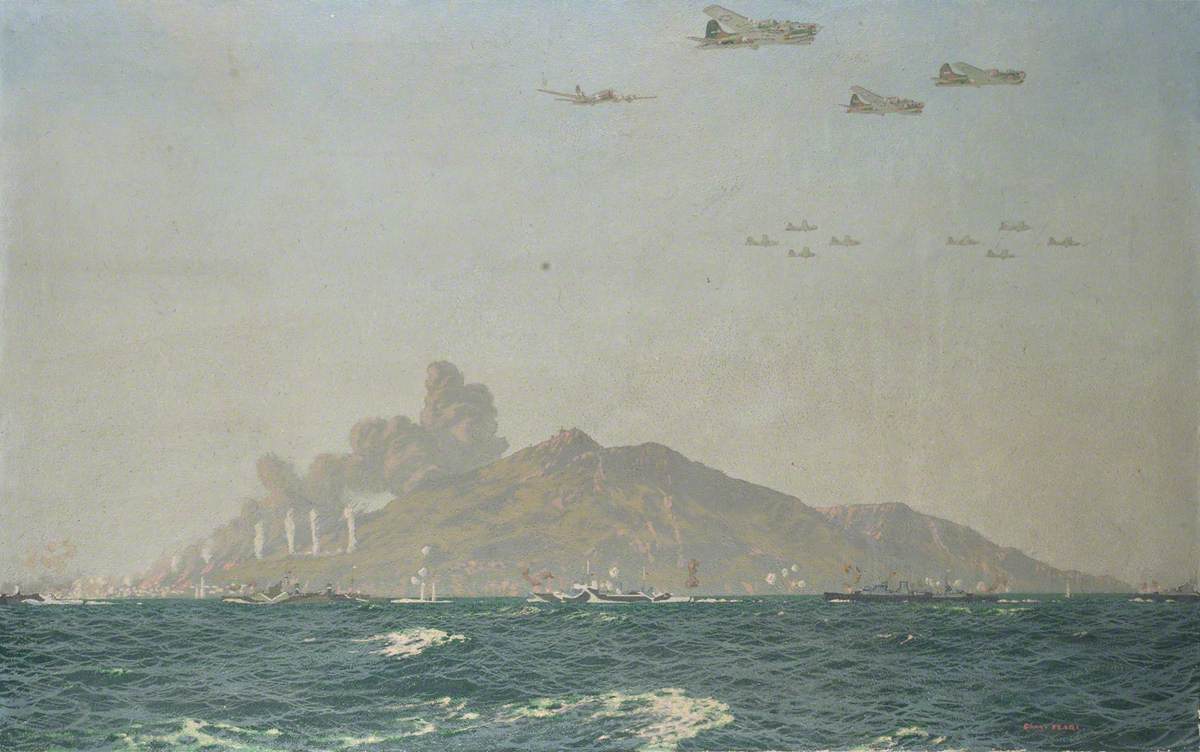Charles Pears (1958)
was a British painter, illustrator and artist. A commissioned officer in the Royal Marines during the First World War, Pears worked also worked as an official War Artist during both the First and Second World Wars.
Handing Over a Convoy from American to British Escorts, 1941 A seascape depicting merchant and military shipping set against a cloudy blue sky with aircraft flying above. Two of the ships in the centre foreground are painted in dazzle camouflage schemes.Bombardment of Pantellaria, Italy, 11 June 1943
A seascape depicting merchant and military shipping set against a cloudy blue sky with aircraft flying above. Two of the ships in the centre foreground are painted in dazzle camouflage schemes.Bombardment of Pantellaria, Italy, 11 June 1943 This painting, signed ‘Chas Pears’ and produced for the War Artists Advisory Committee, shows an action of June 1943 during the Second World War. The small rocky Italian island of Pantellaria lies midway between Tunisia and Sicily, some 140 miles north-west of Malta. Since early in the war it had been of strategic interest to the Allies, but with the surrender of the German forces in Tunisia it became an obvious target for combined British-American attack in spring 1943. Not only would it aid the supply of allied forces in the Middle East and particularly the vital base of Malta, but it would also provide an important base for the proposed invasion of Italy. It was blockaded and bombarded by sea and air until it finally surrendered on 11 June.
This painting, signed ‘Chas Pears’ and produced for the War Artists Advisory Committee, shows an action of June 1943 during the Second World War. The small rocky Italian island of Pantellaria lies midway between Tunisia and Sicily, some 140 miles north-west of Malta. Since early in the war it had been of strategic interest to the Allies, but with the surrender of the German forces in Tunisia it became an obvious target for combined British-American attack in spring 1943. Not only would it aid the supply of allied forces in the Middle East and particularly the vital base of Malta, but it would also provide an important base for the proposed invasion of Italy. It was blockaded and bombarded by sea and air until it finally surrendered on 11 June.
It is the final, clearly irresistible assault that is the subject of Pears’ painting. In a panoramic vista taken from a distant vantage point at sea, it shows the island under siege by both sea and air, with the small town of Pantellaria at the left (north) end of the island encircled by eruptions of shell bursts and overhung with a heavy pall of thick smoke from blazing fires. Across the picture in the middle distance are ranged the force of covering cruisers: at the far left the stern of what might be the ‘Aurora’ with General Eisenhower aboard, then the ‘Penelope’, ‘Newfoundland’, ‘Orion’ and ‘Euryalus’. Above are 12 US Air Force Flying Fortresses returning from unloading their bombs onto the exposed town.
Pears’ focus on the dazzling June sunlight and hazy heat of the southern Mediterranean adds to the sense of unstoppable, glowing victory, while any involvement in the scale and human impact of the assault is deflected by the detached and distant viewpoint. The painting thus serves well its purpose for the War Artists Advisory Committee of both reporting the unfolding events of the war and raising morale for the British public. It was presented to the Museum by the War Artists Advisory Committee in 1946.artuk.org - Charles Pears